What to do with used wind tubine blades? (Photo: Global Fibreglass Solutions, USA)
The first generation of wind turbines is dropping their blades. The durable polyester is a harbinger of the deluge of discarded material that awaits us. Is there anything we can do with it? There are numerous original uses.
This article in 1 minute
- In three years’ time, the Netherlands’ first offshore wind farm will be decommissioned. This will bring 180 wind turbine blades ashore, weighing around 1,200 tonnes.
- This is the harbinger of waste that will reach 40-50,000 tonnes a year in 30 years’ time. What can we do with it?
- So far, the standard option has been to incinerate it and add it to cement, but the processing capacity is too small.
- The blades are light, strong and weather-resistant structures for which creative minds are coming up with surprising applications, from playgrounds to solar islands.
- Researchers at the TU Delft’s Faculties of Industrial Design Engineering and Civil Engineering and Geosciences are developing ways to make wind turbine blades reusable as building materials.
- TNO is gassing the synthetic resin at high temperatures to release the glass fibre, for which they are looking for customers.
Along the A1 near Barneveld, several dozen wind turbine blades are waiting for a second round. At 40 metres long they are small by today’s standards, but when you walk past them they are huge. The base is large enough to stand in upright. The greenish material, fibreglass mats soaked in a plastic resin, polyester or epoxy, is decimetres thick and rock hard. The ring at the base has protruding threaded ends – which attached the blade to the rotor – all round.
What do blades actually weigh? “About seven tonnes,” estimates Wim Robbertsen, Director of a wind turbine company called Business in Wind. He shows how he and his team give wind turbines a second life, often elsewhere in the world.

The world map with pins in his office has few empty spaces left. There is considerable demand for secondhand wind turbines, says Robbertsen. Especially if your company not only sells, but overhauls and installs them as Business in Wind does. Many wind turbines are replaced before the end of their technical lifespan. “With a two megawatt turbine, power at a certain location costs four cents per kilowatt hour,” Robbertsen explains. “If you put a six megawatt turbine there, it’s only three cents per kilowatt hour and you produce three times more power.”
That logic means that turbines are being replaced by larger turbines at many early Dutch wind farms. Robbertsen and his colleagues export the original wind turbines across Europe where they last for years. “On-site restrictions mean that people often prefer smaller turbines. The restrictions could be related to permits, access roads or crane capacity on site.”
Polyester plague?
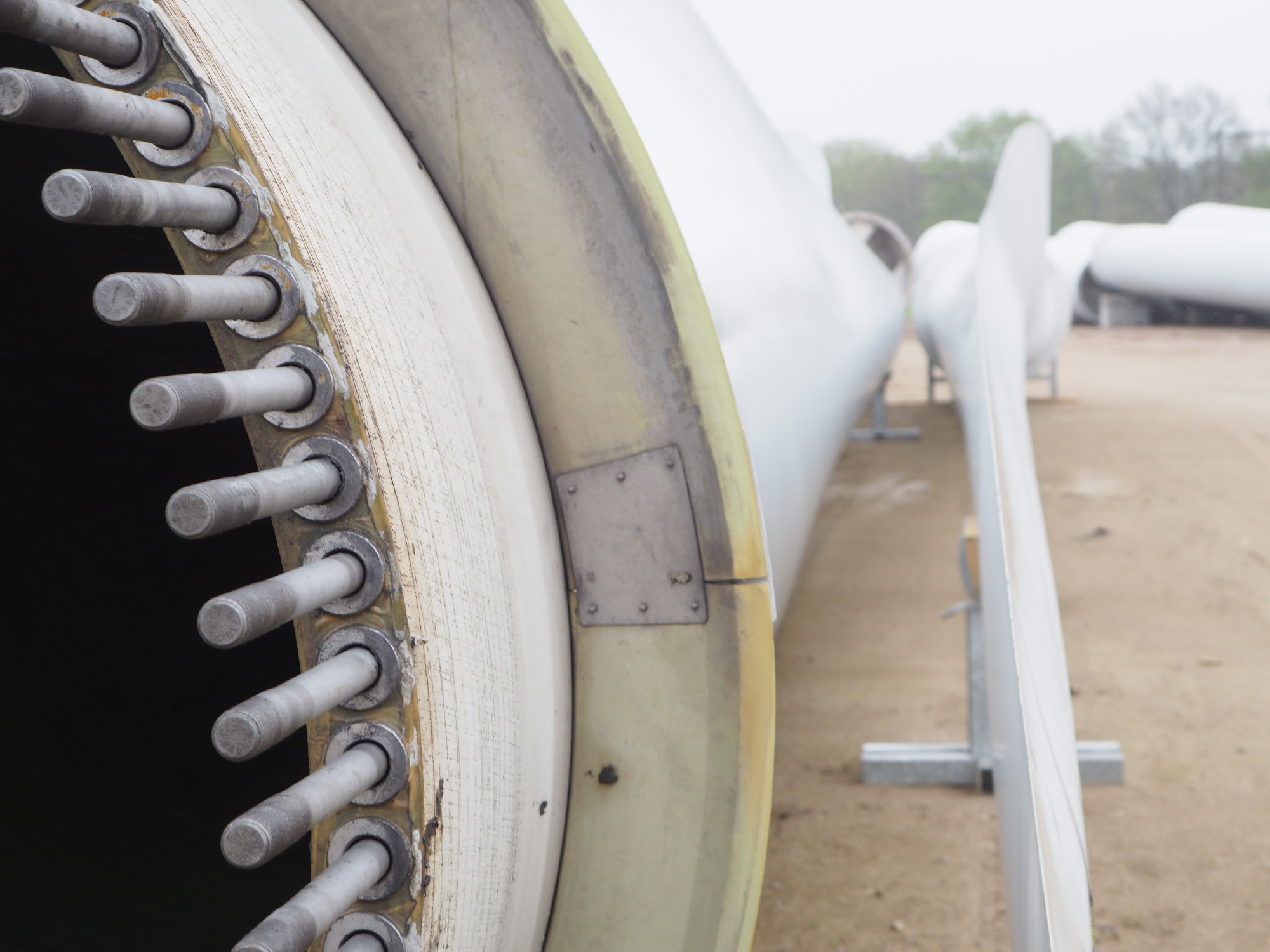
Still, the time comes that every wind turbine is decommissioned. The concrete foundation and the steel mast can be reused, but this is not easy for the blades. The composite material consists of glass or carbon fibre soaked in epoxy, polyester or vinyl ester synthetic resin. It is rock hard, rigid and weatherproof. Put it in a landfill and it will remain there for another 1,000 years. Perhaps overgrown with algae or mould and possibly delaminated by penetrating moisture, but still largely intact. Wind turbine blade dumping will be banned in Europe by 2025, but in the Unites States of America it can still be done. Drive them to a desert, dump them and cover the stash with sand. Problem solved.
For the Netherlands, the polyester problem will become topical in around 2027
Or is it? Worldwide, some 14,000 blades were discarded through to last year after an average useful life of 20 to 25 years. For the Accelerating Blade Turbine Circularity (2020) report, WindEurope, the European wind energy industry association, and its partners calculated that this amounts to 40,000 to 60,000 tonnes of composite waste.
This is the waste from the early years of wind energy when wind turbines were sparse. For the Netherlands, the polyester problem will become topical in around 2027 when the Amalia offshore wind farm will be decommissioned and 180 blades will be brought back to land. Materials scientist Harald van der Mijle Meijer, a TU Delft alumnus and wind energy senior consultant at TNO in Petten, estimates that this amounts to about 1,200 tonnes. He and his group are working on a technique to process plastic composite material, more on this below.
The Amalia offshore wind farm had a capacity of 120 megawatts. By comparison, offshore wind farms built now have capacities of thousands of megawatts. When the turbines from those farms reach the end of their life cycle in 2050, the Netherlands can expect a waste stream of 40,000 to 50,000 tonnes per year. That is 20 to 25 times more than today, states TNO in its Offshore wind farm decommissioning (2021) report, in which Dr Jelle Joustra of TU Delft was involved. He specialises in circular product design with composite materials at the Faculty of Industrial Design Engineering.
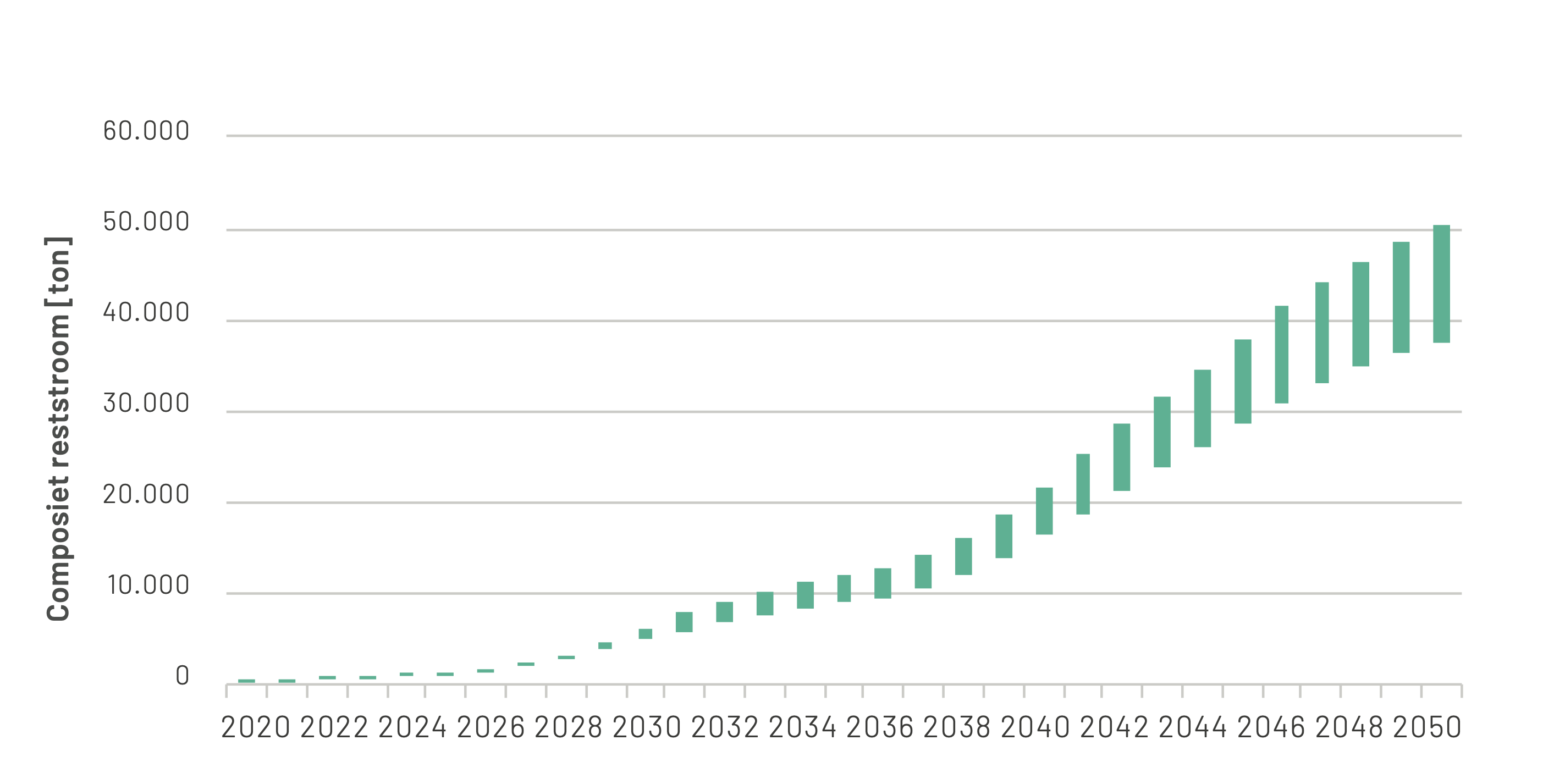
The waste stream of composite materials will increase sharply in the coming decades due to the ageing of large offshore wind farms in the southern North Sea. (Source: TNO, Offshore wind farm decommissioning)
What can be done with discarded wind turbine blades?
- Landfill or incineration
- Reuse in another location (Business in Wind)
- Reuse as a whole or in part
- Reuse parts in construction
- Dissolve the resin and recover the fibres
Incineration
Joustra can get angry about incinerating composite materials. Yet that is what is usually now done with discarded blades: incinerating them as a raw material for cement. In a position paper, a consortium of seven organisations call this cement co-processing ‘a sustainable solution for recycling composite materials’. The shredded composite material used to come mainly from recreational boats but now comes increasingly from wind turbine blades.
‘Glass doesn’t burn at all’
The synthetic resin in the shreds serves as fuel, reducing the amount of energy required for combustion. At sufficiently high temperatures, the glass fibre loses cohesion and reverts to a form of sand that is easy to process into cement. Unlike other options, processing into cement has evolved at industrial scale that processes large quantities of material, say the authors of the paper.

How desirable is this? “Just look at this,” Joustra responds. He taps his hand on the top of the picnic table. The panels for the table have been cut from a wind turbine blade. It feels clean, sleek and solid. “This is beautiful material that can last for a long time. If you can make something like this with it, it’s surely a waste to incinerate?” Besides, incineration is about the only thing composite material is not good at as half of it is made from glass that “doesn’t burn at all.”
Pretty inefficient then if discarded wind turbines disappear into the incinerator. But alternatives are under development.
Creative with plastic
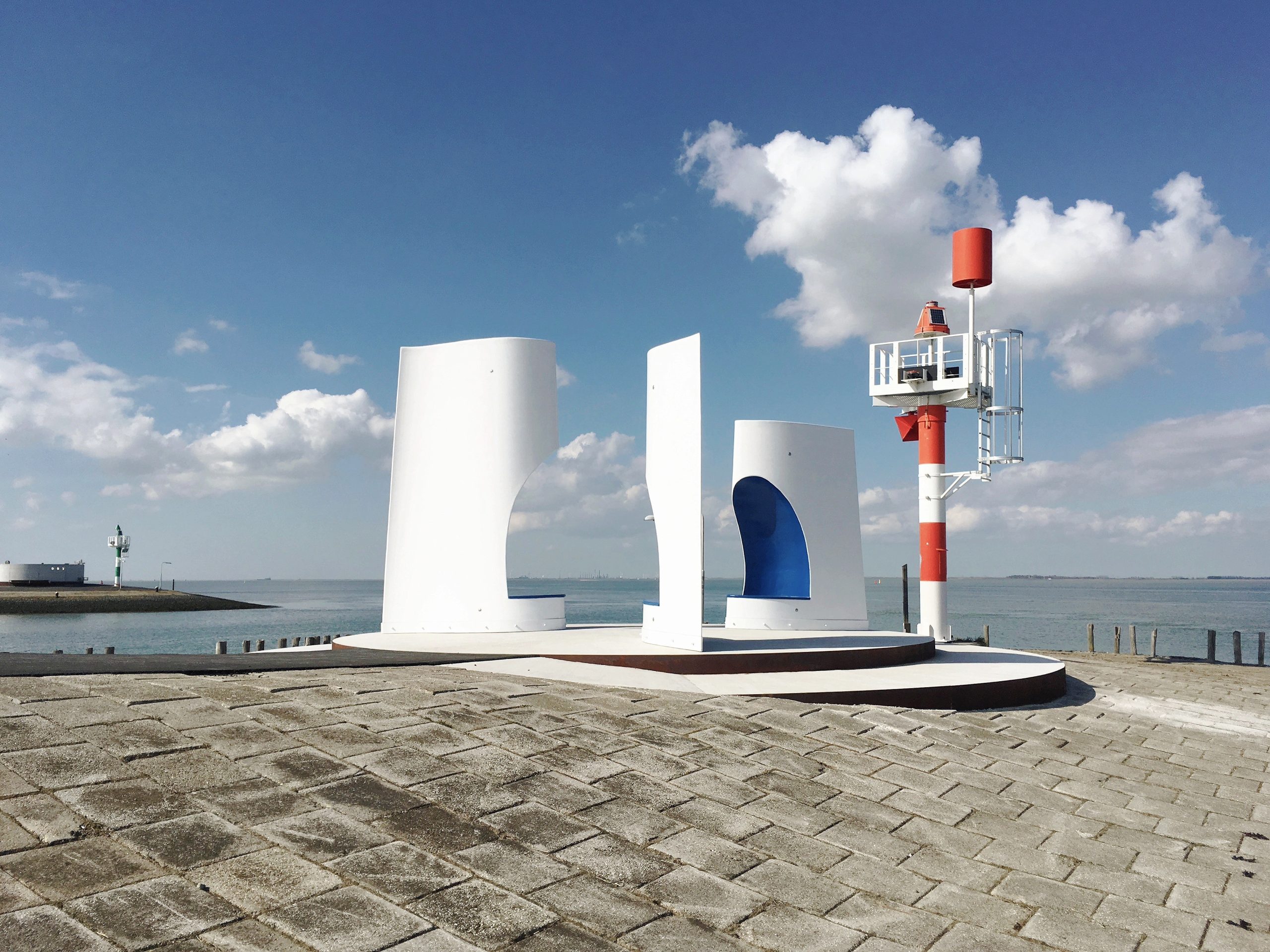
The Superuse international architecture collective has been working on circular designs from Rotterdam since 1997. Almost 20 years ago, members of the Blade-Made spin-off created designs for playful applications for discarded wind turbine blades. The Wikado Playground in Rotterdam (2008) was the first place where fragments of wind turbine blades were given a new life as playground outdoor furniture. “We wanted to create a place where children could hide, climb and crawl through holes,” explains Jos de Krieger, partner at Superuse.
The quality and size of windmill blades proved perfect for this. The makers worked the blades with a diamond saw and rounded off sharp edges with epoxy.
There appears to be a whole chain of possible second lives
In 2016, Blade-Made in Terneuzen made a climbing tower out of a single blade. Meanwhile, the spin-offs portfolio lists benches, bridges, noise barriers, eye-catchers and park furniture. Blade-Made actually sees the durability of composite as an advantage: it produces ‘long-lasting objects that are functional, beautiful and durable’, states its website.

The Re-Wind academic network goes even further in reusing wind turbine blades. It is a collaboration between four universities and the Blade Bridge spin-off company.
Besides bridges, the Re-Wind catalogue includes designs for floating solar meadows, rafts, buoys, piers, noise barriers, huts, shacks, stables, decks and high-voltage pylons. There appears to be a whole chain of possible second lives for the slender, strong, rigid and weather-resistant structures that are wind turbine blades.
Beams and panels
TU Delft researcher Jelle Joustra looks beyond the creative reuse of whole or partial sheets. Sure, there are original applications, he agrees, but these are incidental. It takes a lot of design effort to give one or two blades a new use, he says. “Such repurposing is difficult to scale. You can’t roll it out at a big scale.” And that is what Joustra, as a researcher in the Design for Sustainability department (Faculty of Industrial Design Engineering), is looking to do: create structural solutions for high-performance composites.
‘It’s pretty high-end material. It stays very stiff and strong, even after 25 years of use.’
Outside Joustra’s office is a 1.5 metre high cross-section of a wind turbine blade. The fragment weighs about 150 kilograms and has a sophisticated construction made of various materials. At its thickest point, the front and back of the blade is made of a centimetre-thick solid layer of stacked glass fibres infused with synthetic resin. This thick layer of composite (‘spar caps’) prevents the blade from bending under wind pressure.
Shear webs (laminated foam or balsa wood) and the spar caps are made into a long box-like structure that forms the backbone for the blade. The enveloping wing profile does not have to be strong, but it does have to be light. Honeycomb panels or laminated balsa wood are often used for this purpose[cheerup-read-more] an extremely light wood from Central and South America that was popular in model aircraft construction and is increasingly used in wind turbine blades[/cheerup-read-more].
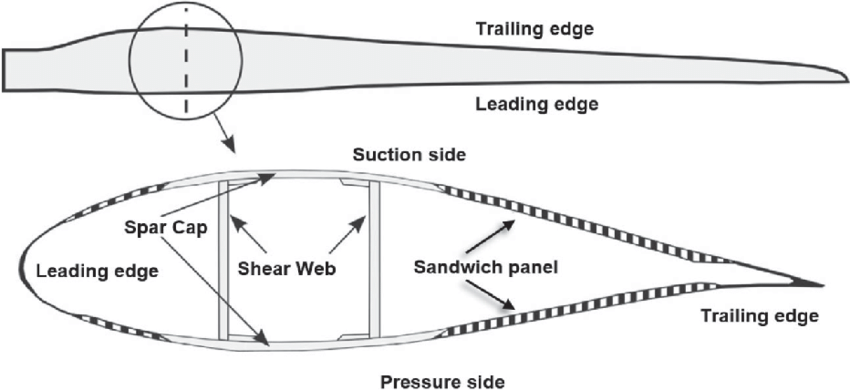
Can you cut a blade into more or less standardised elements? This is what Joustra is working on. Composite material can be cut well with a waterjet. Other types of saws get blunt quickly because of the amount of glass in the composite. Besides this, sawdust from glass or carbon fibre poses risks of lung damage.
Turbine blades can be cut into a range of beams and panels. Joustra believes that this opens up a world of applications. “It’s pretty high-end material. It stays very stiff and strong, even after 25 years of use.”
Construction kit
Could wind turbine blades be used as a construction material? Simon Pronk graduated on in this area in 2022 under Prof. Henk Jonkers (Faculty of Civil Engineering and Geosciences). In his graduation report, Pronk lists possibilities for reuse.
The circular construction box:
- Spar caps – between 30 and 50 millimetres thick solid material. Can be used for foundations, roof construction or floor supports.
- Shear web – the lightweight joints between spar caps, consisting of a laminated layer of foam or balsa wood. Excellent insulation material. Can also be used as insulating cladding or as insulating floor boards.
- Shell panels – Light material that can be used as roofing, fence or ceiling panels.
- Spar caps and shear web together – forms an I-beam suitable for spanning large distances.
As always, there are still some hurdles to overcome before parts of blades can be used as building materials. ‘It is not the most obvious building material and possibly not the cheapest’, writes Pronk. ‘Still, I hope awareness of necessary circularity will encourage someone to take this further’. One of the challenges is to obtain a Eurocode for use as a building material since that requires extensive testing of different materials.
Reclaimed fibres
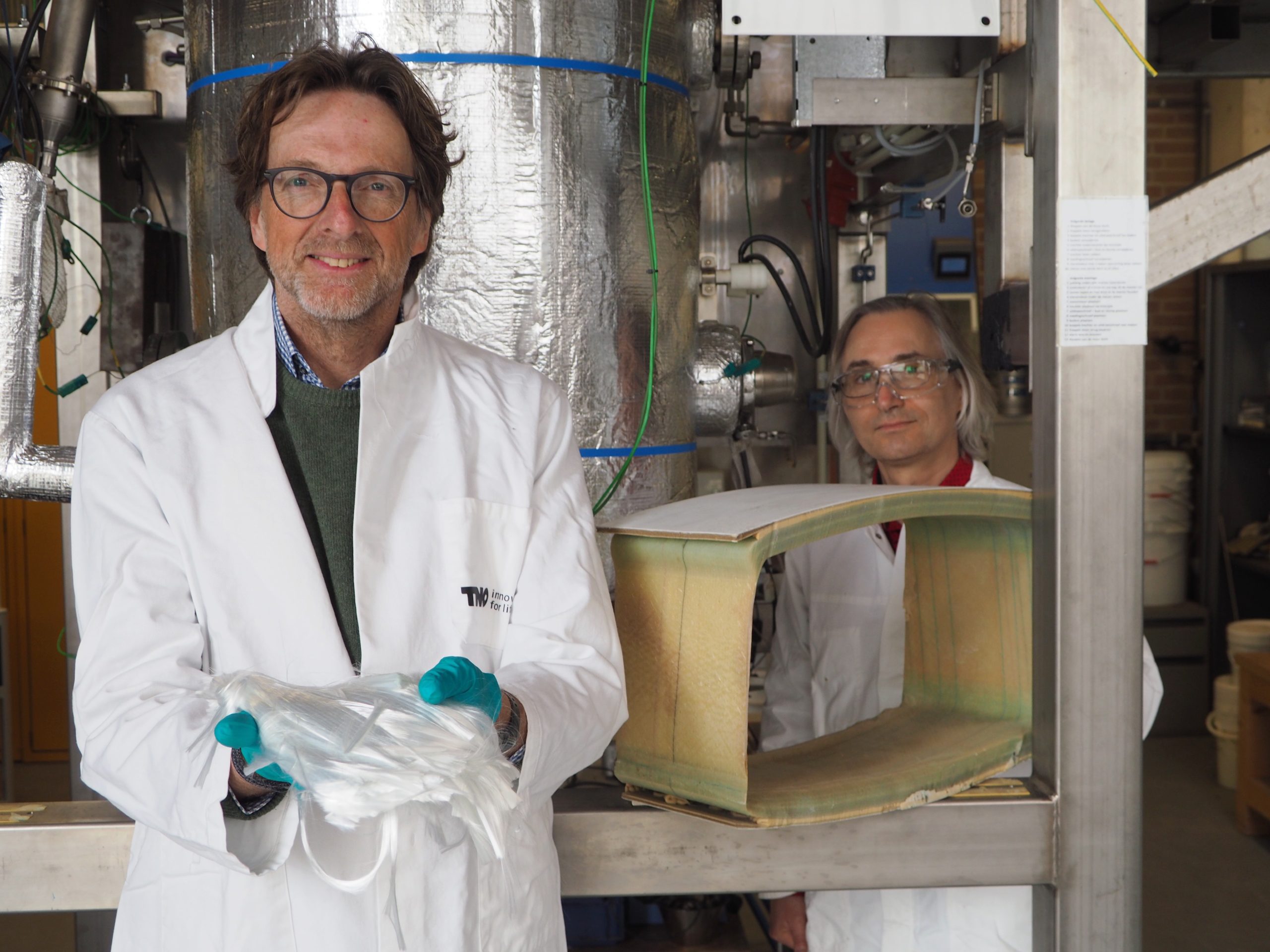
A composite spar cap is a solid piece of material made up of fibreglass and synthetic resin. But if the temperature is raised to 450 degrees Celsius in an oxygen-free environment, the polyester or epoxy resin is converted into gas and only the fibres remain. The gas is partly used as fuel for the next step – heating the fibres to clean them – making the decomposition process energy neutral.
The heating reduces the strength of the fibres, but for many applications this is not a problem
The process is called pyrolysis, literally decomposition by fire. No oxygen is involved, except at the end, explains materials scientist Harald van der Mijle Meijer (TNO). Adding a little oxygen in the reactor burns the last remnant of synthetic resin off the fibres. “We put a sawn-out block in the reactor and at the end of the process there was a neat package of glass fibres,” Van der Mijle Meijer says of the composite processing.
The heating reduces the strength of the fibres, but for many applications this is not a problem. For example, TNO is working with a car manufacturer to incorporate the glass fibres into recyclable panels and parts. Carbon fibres, widely used in modern blades, can also be recovered in this way.
At the reactor, chemist Dr Marius Cieplik (Senior Scientist at TNO) explains that a demonstration reactor that is 10 times larger and has a processing capacity of 50 kilograms per hour is in the pipeline. The industrial scale, about which discussions are ongoing, can handle a multiple of this: one to 10 tonnes of polyester per hour. “Once this is running, they will have to look for more composite material than just from wind turbines,” speculates Van der Mijle Meijer.
Eternal life
In the view of SuperUse partner Jos de Krieger, the composite material of wind turbine blades has many lives. The lifetime of a blade is about 25 years, but after that it can last another 75 years as a bridge or noise barrier along motorways. The next destination is street furniture or construction material and finally as polyester plant stands, stepping stones or coasters. By then, recycling techniques are likely to be more advanced, scaled up and energy-efficient than today.
It would be helpful if composite material becomes traceable, so that materials and composition can be found via a brand or serial number
De Krieger therefore recommends reusing composite material for as long as possible with as little processing as possible. To this end, it would be helpful if composite material becomes traceable, so that materials and composition can be found via a brand or serial number.
According to Van der Mijle Meijer, who is in dialogue with industry on behalf of TNO, manufacturers are interested in traceability. The European wind industry in particular has started to see circularity as an added value. They would be willing to document materials and structures of blades for reuse.
Jelle Joustra envisions a cascade of repeated uses of composite structures. “There is a kind of inevitable downcycling potential,” he explains. “Also literally in terms of size.” A 60 metre blade, for example, yields a 40 metre bridge. This can later in turn be sawn into five metre long beams and one metre long panels. With each reuse, the material gets smaller until it ends up in the shredder and the fibres are recycled.
Joustra says that “I want to find out how best these sheets can be reused to draw lessons on how to design them to be future-proof.” As far as he is concerned, the same applies to composites in car and aircraft parts. Because there too the use of composites is rapidly increasing.
Are we heading for a polyester plague soon? That more and more composites will pop up in our living environment seems inevitable. Some of these will be surprising repurposes. Whether you see this as a plague is a matter of opinion. Even decomposing polyester by heat, its apparent end, is a new beginning for the reclaimed fibres. Thus, composite materials do have an eternal life, which you could also call circularity.
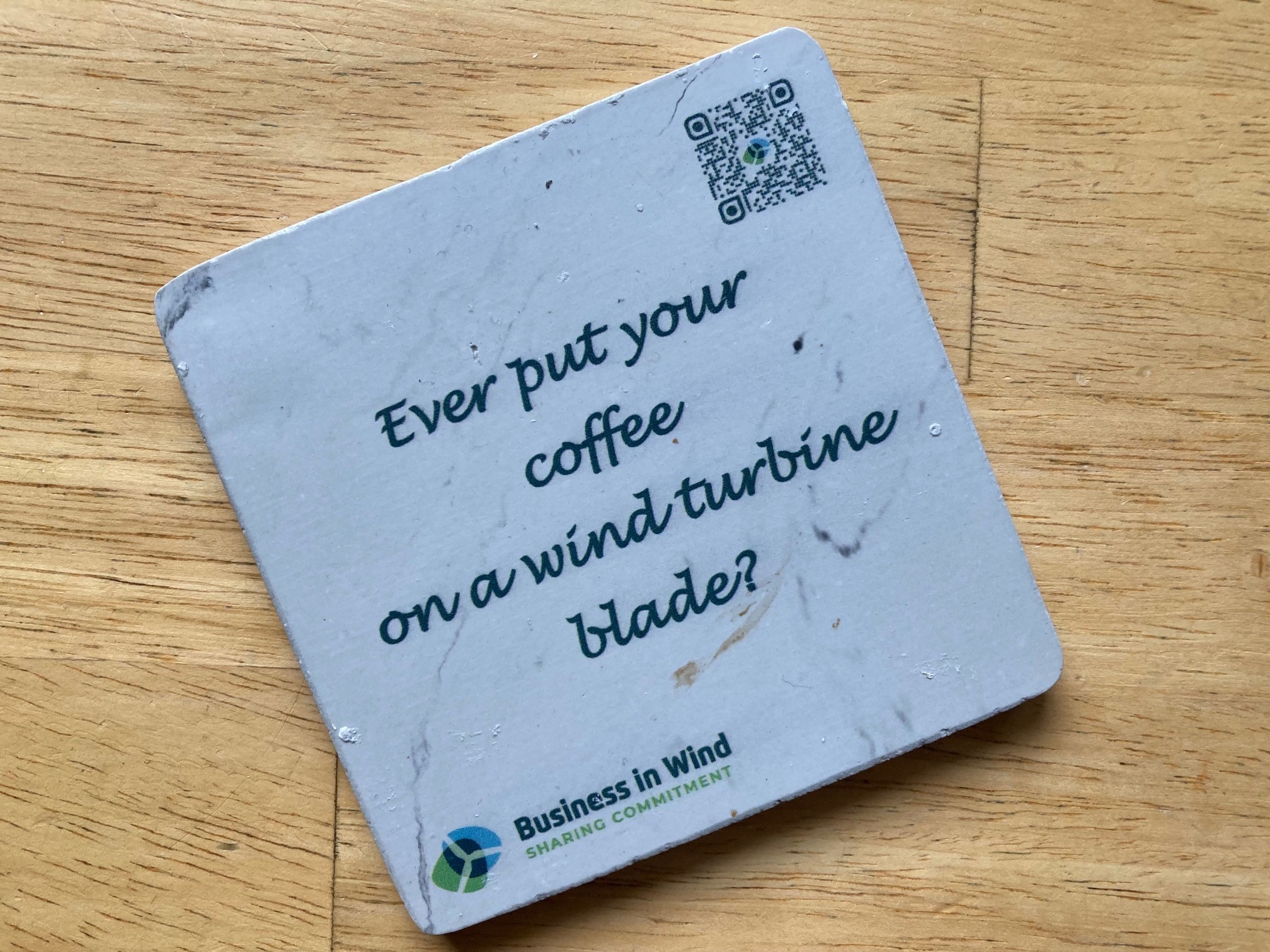
Do you have a question or comment about this article?
j.w.wassink@tudelft.nl

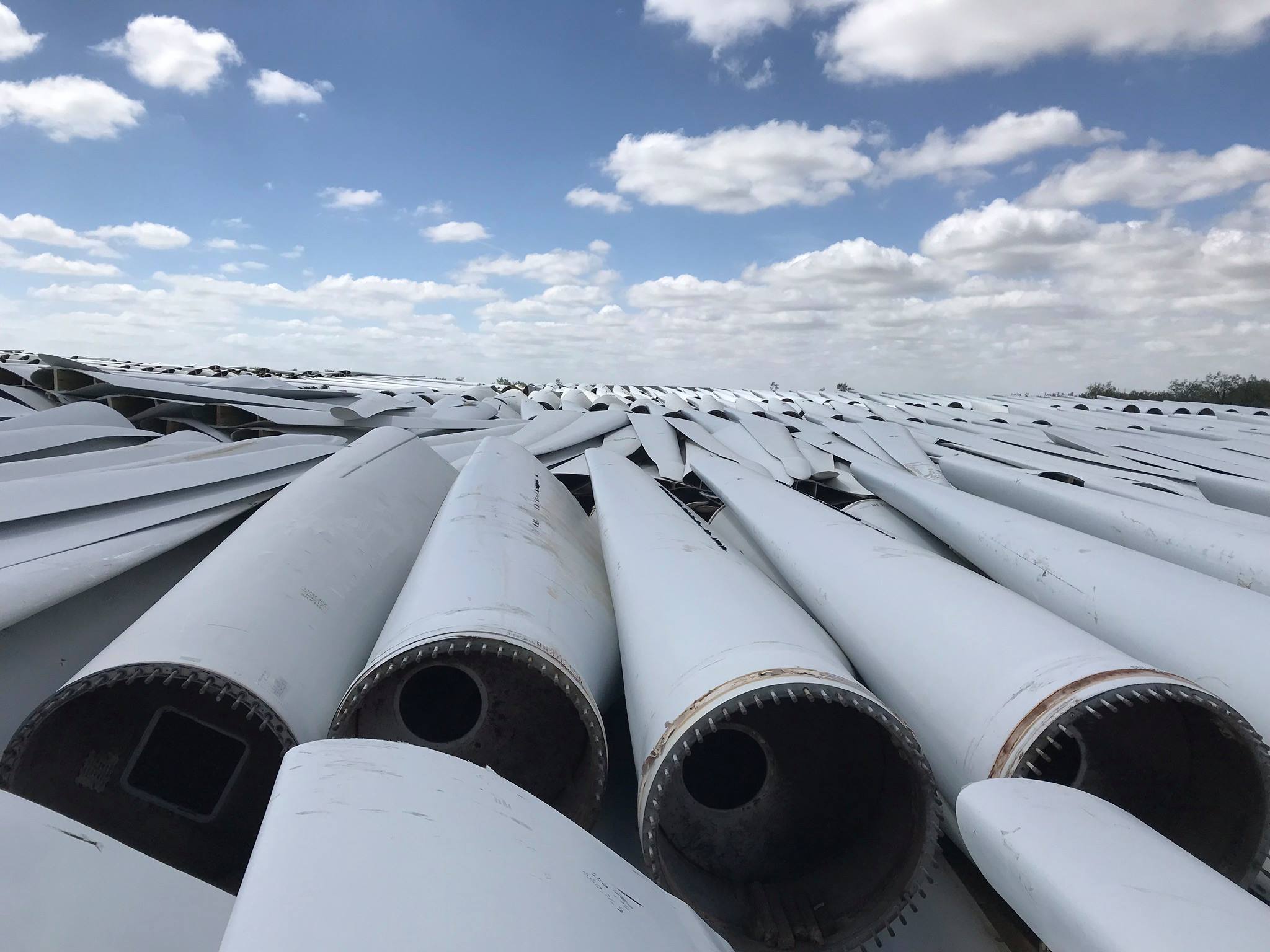
Comments are closed.